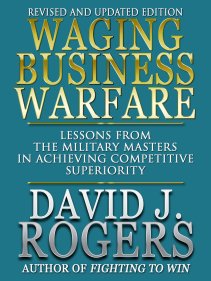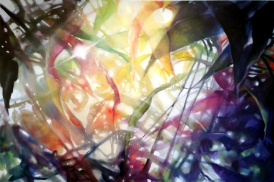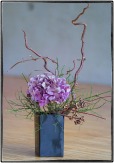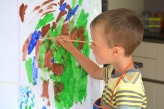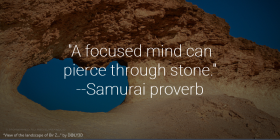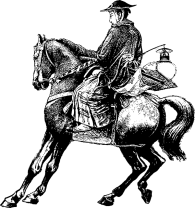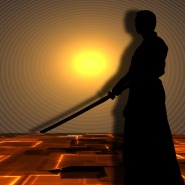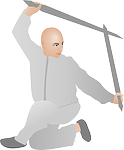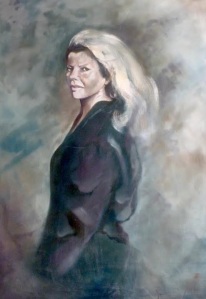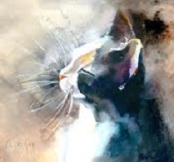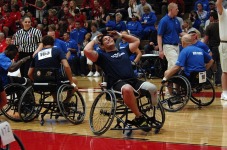My thirty-seven year old son, a school principal and YA author, and a wonderful man, has been a strong supporter of my work since he was a little boy and went with me to store after store while I autographed books. It’s he who suggested I write a blog. That’s when I said, “A what?” So three years ago that’s what, with my wife’s technical help, I started to do. I hope my blog friends are reading this post and will benefit from it. A few years ago my son called me and said, “Dad, in an internet reader’s poll Fighting To Win has been maned the best motivational book ever written.” I said, “Well, how do you like that?” Any creator knows what a joy it is to have his/her work praised. (That’s one reason we work so hard isn’t it?)
 And any author knows that if he writes a book that catches on, he’ll never get rid of it. He will become identified with it the rest of his life. So here I am, the author of Fighting to Win: Samurai Techniques for Your Work and Life. I’m happy to say that that prescriptive how-to-do-it self-improvement book is a classic that since it first came out thirty years ago has been widely used by people of all kinds here and in Europe and Asia as a guide to actualizing their wonderful talents that otherwise may have lain dormant and unused. It started as a book popular with people in the work world, particularly business people, but then quickly spread to people in the arts.
And any author knows that if he writes a book that catches on, he’ll never get rid of it. He will become identified with it the rest of his life. So here I am, the author of Fighting to Win: Samurai Techniques for Your Work and Life. I’m happy to say that that prescriptive how-to-do-it self-improvement book is a classic that since it first came out thirty years ago has been widely used by people of all kinds here and in Europe and Asia as a guide to actualizing their wonderful talents that otherwise may have lain dormant and unused. It started as a book popular with people in the work world, particularly business people, but then quickly spread to people in the arts.
Over the years I’ve received thank-yous from accountants and sales people, and painters, writers, opera singers, composers, movie directors, actors, musicians, and so on–people who’ve come to realize that whatever their walk of life might be, the psychology of the warrior fits them to a T because they are thinly disguised warriors too. It’s a tribute to Fighting to Win that it Is still available as an eBook, is still being read, and is still changing lives.
I turned to the study of the samurai way of life as a result of hard times taking a terrible toll on me. I experienced far too many disappointments and was cheated in business by people I had trusted. I was looking for something that would 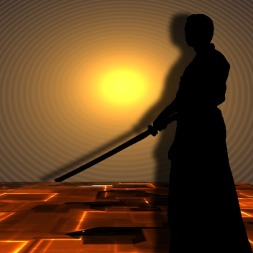 salvage me from the kind of misery I was experiencing and in the samurai Way found strength as well as insights, strategies, and techniques I could use to pull myself out of the awful lethargy I had settled into. By way of the book, magazine articles, TV and radio, the internet, and speeches, I’ve been fortunate to meet many wonderful people. They have told me that they too have found solace from setbacks and gained the psychological and spiritual wherewithal to excel in their careers through samurai wisdom and what I call “the inner skills of creative people.”
salvage me from the kind of misery I was experiencing and in the samurai Way found strength as well as insights, strategies, and techniques I could use to pull myself out of the awful lethargy I had settled into. By way of the book, magazine articles, TV and radio, the internet, and speeches, I’ve been fortunate to meet many wonderful people. They have told me that they too have found solace from setbacks and gained the psychological and spiritual wherewithal to excel in their careers through samurai wisdom and what I call “the inner skills of creative people.”
The samurai of Japan were the greatest warriors who ever walked the earth. Trained to perform phenomenal feats of courage and fearlessness, they were stern, quiet, utterly serious people who devoted their lives to developing their skills, spirits, and minds to the highest possible level.
Just as all creative people face internal obstacles that interfere with their lives, so did the samurai. The bulk of his or her training (there were women samurai) was devoted to overcoming those inner obstacles that are no different than the obstacles you and I and creators of all descriptions face—anxiety, procrastination, self-doubt, hesitation, fear of taking risks, nervousness, discouragement, crippling over-analysis, depression, apprehension, impatience, anger, and more.
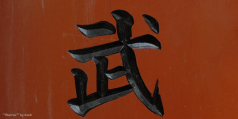
Japanese Character for Warrior
Creators and warriors both begin as ordinary people with the potential to be exceptional and memorable, to apply themselves and acquire impressive skills not everyone possesses, and to develop talents and excel at their chosen life path–their “Way.” Each Way is different: the Way of the painter is similar to yet totally different from the Way of the actor, which is like but different from the Way of the writer or the ballet dancer, etc. At a certain point in their training and development, they cease being ordinary anymore, but have become extraordinary. They have wholly recreated themselves.
To function superbly in their chosen role–the painter to paint, the writer to write, the performer to perform, the samurai to fight–of necessity all must be brave, be bold, take chances, and resist discouragement, fear, hesitations, and self-doubt. Ideal warrior creators have the courage of a lion, the boldness of a gambler, and yet the sensitivity of a butterfly. Critics and nay-sayers are not capable of intimidating them–nothing does. Think how liberating it is to be incapable of being bullied by agents, by publishers, by directors. They are not flustered. Now you are thinking how glorious that would be. When they are facing critical moments, their goal is to be as relaxed as a person sitting down for breakfast, and that’s possible.
I’m sure you know many creators who encounter the fear of performing their craft–that’s one of their fears. When I  visited a successful painter friend of mine I saw the same unfinished painting on the easel. Nothing about it changed month after month. Not a single new brush stroke touched the canvas. Then she moved away and I didn’t see her for a number of years. When we got together again I asked first thing since that was what I was the most curious about: “Whatever happened to that green pastel that was on your easel for so long?”
visited a successful painter friend of mine I saw the same unfinished painting on the easel. Nothing about it changed month after month. Not a single new brush stroke touched the canvas. Then she moved away and I didn’t see her for a number of years. When we got together again I asked first thing since that was what I was the most curious about: “Whatever happened to that green pastel that was on your easel for so long?”
She said, “I never finished it.”
I said, “You were afraid.”
She said, “I was terrified of it.”
I know a singer who has had a successful professional career, but suddenly and inexplicably after five years developed a fear of performing and for two years retired because of it. She read the book, applied what she read, resumed her career, and was more successful than ever. Her ordeal of not being able to perform matured her.
Fear–there are a thousand of them–is the creator’s most formidable foe. You know that: fear of not being good enough or creative enough or smart enough or talented enough, of being rejected by an audience, of never reaching the success you dreamed of since childhood.
Some creators are afraid even to enter their work room in the morning. The creator’s fear tightens him/her up. Confidence disappears and self-punishing self-doubt takes its place. Their thoughts don’t flow as they did when they 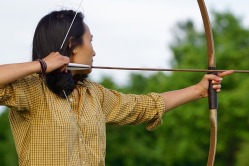 were confident. To create becomes difficult if not impossible. But once creators learn to defeat fear, their minds and spirits are immediately rejuvenated, and creativity flows out of them in torrents: the novel takes shape; the just-right color is added to the canvas. What can possibly stop them now?
were confident. To create becomes difficult if not impossible. But once creators learn to defeat fear, their minds and spirits are immediately rejuvenated, and creativity flows out of them in torrents: the novel takes shape; the just-right color is added to the canvas. What can possibly stop them now?
Warrior creators must always be ready to overcome almost unbearable personal impediments that might stop other people and to overcome scores of obstacles of all sorts standing between them and their highest ambitions. Every year thousands of painters and thousands of writers and other creators give up and quit–just quit–and thousands more are getting ready to quit right now, possibly you. Hopefully they’ll eventually learn that adversity can’t be avoided and in fact is essential to a creator’s development. If only they had persevered a little longer. Persistence is a creator’s good and faithful friend.
When you are a warrior creator your spirit must be strong and poised, in the words of the samurai strong enough to bring down “a wall or iron.” If you are knocked down you must not lie in bed and moan and whine, but must jump up. Knocked down seven times by circumstance you must jump up eight. You must take care that your spirit is never broken, whatever happens.
Your “depths” should never be penetrated. Inside the warrior creator is a tiny core of strength that nothing can touch. You must control your breathing so that energy is released like steam from an engine because the work creators apply themselves to is unbelievably difficult. Tremendous vitality spread over a whole lifetime and put into every poem, every sculpture, and every actor’s role is needed if one wishes to create.
Like samurai, warrior creators strive to remove all psychological blocks, and learn specific techniques for doing that, and having done that to be able to function freely without conscious effort, the way do when you are your most creative. When you are at your best and well trained everything is automatic, the fluid movement of a master swordsman, the ease of the gestures of a violinist, the sure brushstroke of an experienced painter, the rhythmic typing of a writer in the zone.
The work seems to do itself, and everything is easy. The release of the arrow is the most difficult problem the archer  faces. Like the inspiration of the artist, the release “should be done without thought, like a drop of dew falling from a leaf or a fruit falling when it’s ripe.” One’s every creative act should be like the release of an arrow. I’ve seen people like that and so have you.
faces. Like the inspiration of the artist, the release “should be done without thought, like a drop of dew falling from a leaf or a fruit falling when it’s ripe.” One’s every creative act should be like the release of an arrow. I’ve seen people like that and so have you.
All that warrior creators need is within, in their minds. Your mind holds all the secrets. The meaning of all things is within, not something that exists “out there.” Warrior creators “grow from within.” You should leave your mind alone and not complicate it with fruitless anxieties and jealousies so many creators experience. Only then can the mind function uninhibited, in the state of highest creativity.
The mind of the warrior creator must never get “caught” or “snagged” (toroware), or “stopped” (tomaru) on internal obstacles like a fish on a line but should always be flowing smoothly from thought to thought to thought like an unimpeded river. When warrior creators are at their best, their hearts are undisturbed and at total peace, their bodies and minds operating without conscious direction. To the master in any field, to execute their art is no more difficult than to breathe or utter their name.
When most productive warrior creators are confident and self-possessed, they are certain that sooner or later they will succeed. There can be no doubt about that. They are disciplined. Their egos are under control. They look squarely at reality and never flinch from it. If up ahead is something unpleasant, well, up ahead is something unpleasant, so let’s get to it right away and get it over with.
Warrior creators are always trying to improve themselves. Tomorrow they should be smarter, stronger, more knowledgeable, and better skilled than they are today. They do things mindfully, deliberately, and are fully committed. Whatever they do they have every intention of completing. They are “immovable” and don’t budge from their important goals.
Warrior creators are designed to move. They know that when things are done leisurely, seven out of ten turn out poorly.  The Way of the warrior creator is action, action, and more action–getting things done, not procrastinating, not delaying, not stalling, but finishing what you start without delay and going on to the next thing. The main goal of all creators is production–to produce works, an actor to play many roles, the writer to write many stories, the lithographer to work with many plates. No creator is more able to produce voluminous works than men and women of action.
The Way of the warrior creator is action, action, and more action–getting things done, not procrastinating, not delaying, not stalling, but finishing what you start without delay and going on to the next thing. The main goal of all creators is production–to produce works, an actor to play many roles, the writer to write many stories, the lithographer to work with many plates. No creator is more able to produce voluminous works than men and women of action.
The warrior creator knows that when you encounter calamities, it isn’t enough to say you’re not upset, but it is best to “dash forward bravely and joyfully” to meet the difficult situation. What you fear the most you must get to first. Warrior creators accept whatever they are doing and flow with whatever may happen. They are taught to expect nothing but to be mentally and physically prepared for anything.
They focus: the concentration of the artist is astounding to the non-creator. Their lives are focused too, to enable them to do their work without interference. Among their affairs are many responsibilities, but no more than two or three “matters of greatest concern.” The most important time in the warrior creator’s life is the present moment: “There is only one purpose of the present moment, but a person’s whole life is just a succession of present moments.”
For the warrior creator every moment brings with it a CHOICE POINT at which one’s whole life can change: “From this point on, after this present moment ends, shall I be strong or shall I be weak, shall I commit myself to my craft or continue playing at being a painter, shall I buckle down and see what I can become at last?” These are crucial questions.
The warrior creator is to think what a frail thing life is and is reminded that every day of his/her life may be the last.  There is no fear of death. So warrior creators dedicate their lives to the fulfillment of their obligations to others and to themselves. They have an obligation to their art, their craft, and to live with the energy and flexibility that go into a creator’s every work: “Never let the thought of a along life seize upon you, for then you are apt to indulge in all kinds of wasteful dissipation.”
There is no fear of death. So warrior creators dedicate their lives to the fulfillment of their obligations to others and to themselves. They have an obligation to their art, their craft, and to live with the energy and flexibility that go into a creator’s every work: “Never let the thought of a along life seize upon you, for then you are apt to indulge in all kinds of wasteful dissipation.”
The warrior creator turns back again and again to the creative work to be done in this much too brief life, this single blessed moment that is occurring right now.
© 2017 David J. Rogers
For my interview from the international teleconference with Ben Dean about Fighting to Win, click on the following link:
Interview with David J. Rogers
Order Fighting to Win: Samurai Techniques for Your Work and Life eBook by David J. Rogers

Click on book image to order from Amazon.com
or
http://www.barnesandnoble.com/w/fighting-to-win-samurai-techniques-for-your-work-and-life-david-rogers/1119303640?ean=2940149174379
Order Waging Business Warfare: Lessons From the Military Masters in Achieving Competitive Superiority

Click on book image to order from Amazon.com
or
http://www.barnesandnoble.com/w/waging-business-warfare-lessons-from-the-military-masters-in-achieving-competetive-superiority-revised-edition-david-rogers/1119079991?ean=2940149284030
 The breathtaking Hawaiian Islands are an inappropriate place to become ill, but Honolulu, their state capital, largest city, and principal port, is where my younger sister Sharon had chosen to live–where the last months of her life she was hospitalized. In her early twenties she had left Chicago where we had grown up and I still live and she had visited one exquisite picture post card place after another in Spain, France, the South Pacific, and the Mediterranean, and so on, in search of the single place where she thought she would be happiest living and had found it.
The breathtaking Hawaiian Islands are an inappropriate place to become ill, but Honolulu, their state capital, largest city, and principal port, is where my younger sister Sharon had chosen to live–where the last months of her life she was hospitalized. In her early twenties she had left Chicago where we had grown up and I still live and she had visited one exquisite picture post card place after another in Spain, France, the South Pacific, and the Mediterranean, and so on, in search of the single place where she thought she would be happiest living and had found it. On the nights of my visit after seeing her I would walk on the beaches, reflecting on the day, finding restful the fresh air and coolness, and sleeping at Sharon and Ron’s apartment. On the kitchen floor there was a scale to measure the dwindling of my sister’s existence, and sheets of paper on a clipboard suspended from a nail on the wall that recorded her declining weight: ninety-eight pounds, ninety, eighty-eight…and a calendar that had Xs on days she wasn’t healthy enough to work that in recent months had become all Xs. Against a wall there was a full-length gold-framed mirror that in the past she had looked into. The mirror was dusty.
On the nights of my visit after seeing her I would walk on the beaches, reflecting on the day, finding restful the fresh air and coolness, and sleeping at Sharon and Ron’s apartment. On the kitchen floor there was a scale to measure the dwindling of my sister’s existence, and sheets of paper on a clipboard suspended from a nail on the wall that recorded her declining weight: ninety-eight pounds, ninety, eighty-eight…and a calendar that had Xs on days she wasn’t healthy enough to work that in recent months had become all Xs. Against a wall there was a full-length gold-framed mirror that in the past she had looked into. The mirror was dusty. There was no need for Kathy and me to discuss where Sharon stood. It needn’t be said that it wouldn’t be long and that soon Sharon would be gone entirely from my life and from the world. I knew that the moment coming from the airport and entering her hospital room and putting down my bag when I saw with a shock how puny Sharon looked now. The illness had given her an old woman’s body that had been ravaged by suffering there in that bed that was now her final home–so skinny–all bones–very sick–dying. The pain had turned her black hair white and it was short from the treatment and no longer long. Her once-pretty face was gaunt, her cheeks gray, her body very tired. Her long pianist’s fingers were so thin that her ring had slipped off and was lost. But there in her gray, lonely, fading beauty there was still about her that same gentleness you could ruffle with your breath, the same spirit in her fierce eyes, the same poise, and the same elegance. Looking into my eyes, imagining what I was seeing, Sharon had clutched her gown across her chest in embarrassment –covering herself in shame–still a modest woman–and said, breaking my heart, sucking the breath out of my lungs, “I’m a mess aren’t I?,” and I had replied to her, “Shar, you are beautiful.”
There was no need for Kathy and me to discuss where Sharon stood. It needn’t be said that it wouldn’t be long and that soon Sharon would be gone entirely from my life and from the world. I knew that the moment coming from the airport and entering her hospital room and putting down my bag when I saw with a shock how puny Sharon looked now. The illness had given her an old woman’s body that had been ravaged by suffering there in that bed that was now her final home–so skinny–all bones–very sick–dying. The pain had turned her black hair white and it was short from the treatment and no longer long. Her once-pretty face was gaunt, her cheeks gray, her body very tired. Her long pianist’s fingers were so thin that her ring had slipped off and was lost. But there in her gray, lonely, fading beauty there was still about her that same gentleness you could ruffle with your breath, the same spirit in her fierce eyes, the same poise, and the same elegance. Looking into my eyes, imagining what I was seeing, Sharon had clutched her gown across her chest in embarrassment –covering herself in shame–still a modest woman–and said, breaking my heart, sucking the breath out of my lungs, “I’m a mess aren’t I?,” and I had replied to her, “Shar, you are beautiful.” the happy girl and boy that we had once been, getting ready to ride our bikes to the library. The gray interior lights were dimmed low, as if the plane itself were drowsy. Everything was silent but for the deep hum of the engines, the other passengers asleep. I wanted to prepare myself for what it would be like now without a sister, my parents without a daughter, my children without an aunt.
the happy girl and boy that we had once been, getting ready to ride our bikes to the library. The gray interior lights were dimmed low, as if the plane itself were drowsy. Everything was silent but for the deep hum of the engines, the other passengers asleep. I wanted to prepare myself for what it would be like now without a sister, my parents without a daughter, my children without an aunt.
